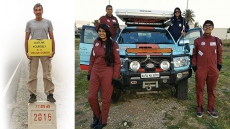"We use our sanctuary as a living laboratory. It becomes a way for people to see how Mother Nature, if given half a chance, will regenerate herself.” Pamela Malhotra, co-founder of SAI Sanctuary.
The debate on environmental activism may have gained a tumultuous momentum in recent years but the struggle to bringjustice for all the harm and damage done to the environment has been a long one. From writers, leaders and politicians to students, educators and average citizens, the journey to bring environmental reforms has recorded excruciating accounts of protests, punishment and purge of environment-dependent communities. From India’s Chipko movement that started in the 1970s to resist the destruction of forests, to the Dakota Access Pipeline protests in the United States that demonstrated against threat to the region’s clean water and ancient burial grounds, there have been several movements to preserve an undisrupted harmony with the environment. One of these movements has been the Save Animals Initiative (SAI) Sanctuary.
Located in the Southern region of India, the Sanctuary has grown leaps and bounds to own up to it’s name. SAI Sanctuary mentions on their website that “the Sanctuary’s rich variety of flora includes hundreds of different indigenous trees and plants – many of medicinal value – as well as numerous rare and threatened species of animal.” More than 300 different kinds of birds frequent the forest canopy, according to SAI Sanctuary.
In 1991, Dr. Anil Malhotra and Pamela Malhotra established the SAI Sanctuary, which is probably India’s first private wildlife sanctuary. The couple has dedicated more than two decades to the forest and cause, however, the landscape was very different when they first arrived with the mission to transform this depleted piece of land into a sanctuary. “When I came here with a friend who suggested I buy this land, it was a wasteland of 55 acres. The owner wanted to sell [it] because he couldn’t grow coffee or anything else,” Anil said while speaking to The Times of India in an interview and added, “For me and Pamela, this was what we were looking for all our life.”

The couple met in the US where Anil was running a restaurant business and Pamela was a sales representative for a pharmaceutical company. Their love for nature and the environment motivated them to first settle in Hawaii. They bought land and began their long envisioned conservation efforts. Anil and Pamela ventured into organic farming on a small portion of land, intended for personal consumption. Excess produce was donated to a local women’s shelter. For a brief period of time, everything seemed to be functioning fine but they soon realized that invasion of construction projects were wreaking havoc on the ecosystem of the island. Other factors such as extravagant tourism and import of supplies from the mainland at 40 per cent higher value, further dampened their conservation efforts.
Due to Anil’s father’s severe illness at this point, the couple was forced to fly to India. This was also an opportunity for them to introspect their work and future on the island.
Despite a few hiccups, their trip to India became the advent of a series of events eventually leading to the establishment of what is now the SAI Sanctuary. After exploring their options for establishing a sanctuary in North India, Anil and Pamela, mesmerized by the beauty and lured by opportunities in Southern India, decided to call Kodagu, Karnataka, home for their sanctuary. “We’re not only seeing more of the species we had in the past, but even additional ones, some of which are quite endangered like the Nilgiri marten and, of course, the Asian elephant. Over the past few years the Asian elephants have come to the Sanctuary and given birth four times – two boys and two girls. We have grass eaters like sambar and chital. We have also seen leopard cats. They come here because they feel safe. There is plenty of water. They can bring infants here without fear of human interference,” Pamela told media.

Amongst other challenges, hunting, poaching and gaining the trust of local communities was a challenge for the couple. Pamela narrates an incident to media saying that a priest at a temple nearby was killed by a tiger. With little awareness about extinction and the importance of wildlife conservation, villagers were favourable of hunting animals to secure a safe environment for themselves. For Anil and Pamela, gaining the trust of villagers was a challenge but when they referred them to the stories of Hanuman and Ganesha, deities in the Hindu culture, it was easy for them to connect to the issue. The couple also worked with the forest department to set up camera traps and keep poachers at bay.
Anil and Pamela hope that people and especially youth will come forward to create and participate in environment and wildlife conservation efforts. Pamela tells media “This is our life’s work and it’s been the most fulfilling experience of our lives. We’d love to pass on to others what we’ve learnt and help inspire them. Because truly our future as a beautiful living planet is dependent on it.” To support their efforts, please visit,
www.saisanctuary.com.
Photos: SAI Sanctuary, The Better India, Infinite Windows, iStock




